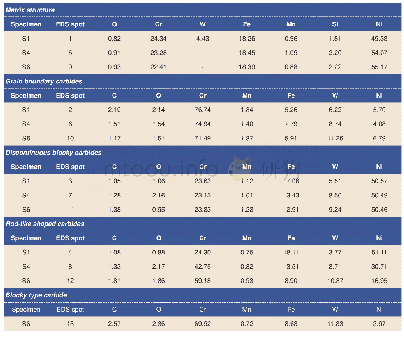《Table 2:EDS analysis of spots given in Fig.3 (wt.%)》
 提示:宽带有限、当前游客访问压缩模式
提示:宽带有限、当前游客访问压缩模式
本系列图表出处文件名:随高清版一同展现
《"Influence of solution treatment on microstructure, corrosion resistance, and oxidation behavior of cast G-NiCr28W alloy"》
EDS analysis of the spots given in Fig.3 could be seen in Table 2.Oxygen was determined in all samples due to the application of the solution treatment processes at atmospheric conditions.Matrix structures of S1,S4 and S6 were a nickel rich phase,and the matrix phase contained tungsten in S1.However,the amount of the carbide forming elements(chromium and tungsten)in the matrix structure decreased from S1 to S6.Grain boundary carbides were chromium based carbides and tungsten content of the grain boundary carbides was increased by the solution treatment process applied at 1,160°C for 8 h.In particular,dissolution of intragranular carbides and reduction of carbide forming elements proportion in the matrix structure led to the formation of tungsten enriched grain boundary carbide.Discontinuous blocky and rod-like shaped carbides were nickel rich carbides with a small amount of chromium and tungsten.There was no significant change in thechemical composition of discontinuous blocky carbides despite a small increase in the tungsten ratio.However,according to the EDS analysis of rod-shaped like carbides,it can be seen that the chromium and tungsten ratio was increased at the elevated solution treatment temperature due to the diffusion of carbide forming elements.S6 was different from other samples with the formation of blocky type carbide.Blocky type carbide was different in terms of elemental composition from the discontinuous blocky and the rod-like shaped carbides,while it was different in terms of shape and larger grain size from the grain boundary carbides.Blocky carbides occurred at grain boundaries of S6 and diffusion of carbide forming elements from the matrix was quite effective for the nucleation and growth of these types of carbides at grain boundaries.Thus,the high temperature process(1,160°C for 8 h)caused the formation of blocky carbides,which were enriched in terms of chromium and tungsten,with induced high diffusion rates.
| 图表编号 | XD0049759400 严禁用于非法目的 |
|---|---|
| 绘制时间 | 2019.01.01 |
| 作者 | Alptekin Kisasoz |
| 绘制单位 | Yildiz Technical University, Department of Metallurgical and Materials Engineering, Davutpasa Campus |
| 更多格式 | 高清、无水印(增值服务) |





